Abstract
African swine fever (ASF) is currently causing an epizootic, affecting pigs throughout Eurasia, and causing significant economic losses in the swine industry. ASF is caused by African swine fever virus (ASFV) that consists of a large dsDNA genome that encodes for more than 160 genes; few of these genes have been studied in detail. ASFV contains four multi-gene family (MGF) groups of genes that have been implicated in regulating the immune response and host specificity; however, the individual roles of most of these genes have not been well studied. Here, we describe the evaluation of the previously uncharacterized ASFV MGF110-1L open reading frame (ORF) using a deletion mutant of the ASFV currently circulating throughout Eurasia. The recombinant ASFV lacking the MGF110-1L gene (ASFV-G-ΔMGF110-1L) demonstrated in vitro that the MGF110-1L gene is non-essential, since ASFV-G-ΔMGF110-1L had similar replication kinetics in primary swine macrophage cell cultures when compared to parental highly virulent field isolate Georgia2007 (ASFV-G). Experimental infection of domestic pigs with ASFV-G-ΔMGF110-1L produced a clinical disease similar to that caused by the parental ASFV-G, confirming that deletion of the MGF110-1L gene from the ASFV genome does not affect viral virulence.
1. Introduction
Until recently, African swine fever (ASF) was historically endemic in Africa and Sardinia (Italy). In 2007, a highly virulent strain of African swine fever virus (ASFV), ASFV strain Georgia (ASFV-G), was introduced into the Republic of Georgia, quickly spreading into neighboring countries throughout Eastern Europe [1]. Then, in 2018, ASF was introduced into China, where the disease quickly spread across Southeast Asia. In 2020, ASF was first detected in Germany, although as of this publication it has been detected only in the wild boar population. This continued seemingly uncontrolled spread of ASFV has the potential to cause a worldwide protein availability shortage, as well as large economic losses in the swine industry [2].
ASF is a frequently lethal viral disease of swine caused by a large dsDNA virus (180–190 kilobase pairs), known as ASFV. Depending on the viral isolate, the viral infection can produce various clinical presentations in domestic pigs, from being sub-clinical to highly lethal [3]. Currently, there is no commercial vaccine available for ASF. To control outbreaks, susceptible animals in infected farms are culled, and strict biosecurity measures are implemented to prevent the introduction of ASFV onto uninfected farms. ASFV experimental vaccines have shown promise against the current circulating strain in Europe and Asia; these vaccines are live attenuated viruses containing the deletion of one or more proteins from contemporary field isolates [4,5,6,7,8,9]. It is important to understand the role of individual genes in ASFV, as well as how their possible manipulation could be used to develop experimental vaccines, and/or to have the tools necessary to develop the next generation of ASF vaccines.
ASFV has more than 160 open reading frames (ORFs) [1]. Few of these ORFs have been experimentally characterized, with their predicted functional role based solely on sequence homology to previously investigated proteins. The role of specific ASFV genes involved in viral virulence is largely unknown [3]. The identification of viral proteins that are important for in vitro and/or in vivo virus replication or virus virulence is critical information needed to develop novel antivirals or vaccines for disease control. The discovery of ASFV gene function using genetic manipulation techniques has resulted in several experimental ASFV live-attenuated vaccines [4,5,8,10,11]. Only a small number of virus genes have been successfully deleted from the ASFV genome, producing novel deletion mutants of the virus (e.g., TK, NL, CD2, MGF360-16R, MGF360-1L, L83L, C962R and X69R) [12,13,14,15,16,17,18], as well as another small number of genes determined to be essential for virus replication (e.g., EP152R, p30, p54 and p72) [19,20,21,22]. The absence of this experimental information greatly restricts the knowledge for most ASFV proteins only to predicted functions by functional genomics.
The MGF110 family consists of thirteen highly diverse paralogs among genomes [23]. The ASFV-G genome contains 11 different MGF110 family genes (1L, 2L,3L,4L, 5L-6L, 7L, 9L, 10-14L, 12L, 13La and 13Lb) all contained in the left terminal repeat region. Fusion(s) between some MGF110 proteins and frameshift mutations vary among ASFV genomes; the ASFV-G genome contains a fusion of the MGF110 5L and 6L proteins, as well as the 10L and 14L proteins. The ASFV-G ORF 13L has a frameshift mutation that splits the ORF into 13La and 13Lb genes. Interestingly, the only MGF110 gene that is present in all ASFV genomes is MGF110-1L, suggesting that MGF110-1L is necessary for ASFV survival. This study aims to investigate the role of the previously uncharacterized MGF110-1L.
2. Materials and Methods
2.1. Viruses and Cells
Primary swine macrophage cell cultures were prepared from defibrinated swine blood, as previously described [24]. Swine blood was treated with heparin and incubated at 37 °C for 1 h to allow erythrocyte separation. Mononuclear leukocytes were purified by a Ficoll-Paque (Pharmacia, Piscataway, NJ, USA) density gradient (specific gravity, 1.079). The monocyte/macrophage cell fraction was cultured for 48 h at 37 °C under 5% CO2.
Adherent cells were detached from the Primaria flasks and reseeded into Primaria T25, 6- or 96-well dishes at a density of 5 ×106 cells per ml for use in assays 24 h later. ASFV Georgia (ASFV-G) was a field isolate kindly provided by Dr. Nino Vepkhvadze, from the Laboratory of the Ministry of Agriculture (LMA) in Tbilisi, Republic of Georgia [10].
Comparative growth curves between ASFV-G-ΔMGF110-1L and parental ASFV-G were performed in primary swine macrophage cell cultures in 24-well plates, and infected at an MOI of 0.1 (based on HAD50 (50% hemadsorbing doses), as previously determined in primary swine macrophage cell cultures). After 1 hour of adsorption at 37 °C under 5% CO2 the inoculum was removed, and the cells were rinsed two times with PBS. The monolayers were then rinsed with macrophage media and incubated for 2, 24, 48, 72 and 96 h at 37 °C under 5% CO2. At appropriate times post-infection, the cells were frozen at ≤221270 °C, and the thawed lysates were used to determine titers by HAD50/mL in primary swine macrophage cell cultures. All samples were run simultaneously to avoid inter-assay variability. Virus titration was performed on primary swine macrophage cell cultures in 96-well plates. Virus dilutions and cultures were performed using macrophage medium. The presence of the virus was assessed by hemadsorption (HA), and virus titers were calculated as previously described [25].
2.2. Construction of the MGF110-1L Deletion Mutant ASFV
Recombinant ASFV-G-ΔMGF110-1L was generated by homologous recombination between the parental ASFV genome and a recombination transfer vector, following previously described procedures [6]. The recombinant transfer vector (p72mCherryΔMGF110-1L) contained flanking genomic regions: the left arm is located between genomic positions 6003–7003, and the right arm is located between genomic positions 7649–8649 and a reporter gene cassette containing the mCherry fluorescent protein (mCherry) gene under the control of the ASFV p72 late gene promoter [26]. The recombinant transfer vector was obtained by DNA synthesis (Epoch Life Sciences, Sugar Land, TX, USA). This construction created a 645-nucleotide deletion between nucleotide positions 7004-7648, deleting the complete ORF sequence of MGF110-1L (Figure 1). Macrophage cell cultures were infected with ASFV-G and transfected with p72mCherryΔMGF110-1L. The deletion mutant ASFV-G-ΔMGF110-1L was purified to homogeneity by successive rounds of limiting dilution purification, using the highest dilution with detectable amounts of mCherry. ASFV DNA was extracted from infected cells, and a full-length sequence using next-generation sequencing (NGS) was obtained, as described previously [26], using an Illumina NextSeq500 sequencer with standard sequencing protocols. Analysis of the sequence was done using CLC Genomics Workbench software version 20 (QIAGEN, Hilden, Germany).
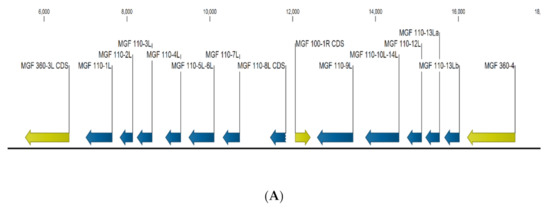
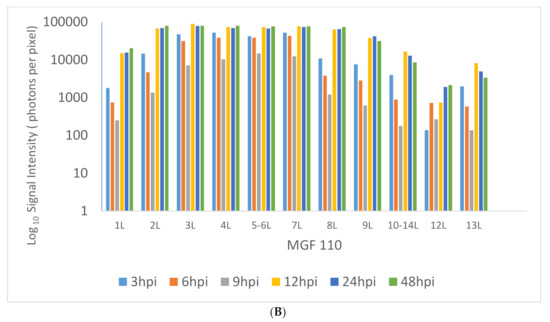
Figure 1.
(A) Location and orientation of all MGF110 family of genes. The MGF110 genes are depicted in Blue. Other multi-gene family (MGF) genes within this region of the ASFV-G genome are depicted in yellow (B) Expression levels of individual MGF 110 genes at the indicated timepoints, expression is measured in Log10 Signal Intensity.
2.3. Animal Experiments
ASFV-G-ΔMGF110-1L was assessed for its virulence phenotype relative to the parental ASFV-G virus using 36-41-lilogram commercial breed swine. Five pigs were inoculated intramuscularly (IM) with 102 HAD50 of ASFV-G-ΔMGF110-1L, and compared with a group of pigs inoculated with similar doses of ASFV-G. Clinical signs (anorexia, depression, fever, purple skin discoloration, staggering gait, diarrhea and coughs) and changes in body temperature were recorded daily throughout the experiment. Animal experiments were performed under biosafety level 3 conditions in the animal facilities at Plum Island Animal Disease Center, following a strict protocol approved by the Institutional Animal Care and Use Committee (225.01-16-R_090716)
3. Results and Discussion
3.1. Expression and Location of MGF110 Family of Genes
The MGF110 family of genes in ASFV-G is located in the Left Variable region between nucleotide positions 7004 and 16031. This 9kb region contains all 110 genes and one other multi-gene family (MGF) gene, MGF100-1R (Figure 1A). The transcriptional activity of the MGF110 family of genes during the infectious cycle was analyzed using deposited microarray data from a previous study [27]. Transcription was detected for all MGF genes at all time points, increasing throughout the experiment, with a dip in expression levels similar to what has been observed with early gene p30. Interestingly, MGF110-8L was detected despite not having a traditional start codon, suggesting that an alternative start site was able to drive the expression of this ORF.
The presence of the MGF110 family RNA transcripts was detected by DNA microarray analysis, as we have previously reported, and are available in the GEO repository under the series record GPL26793 [6]. All MGF110 family of transcripts were detected at all time points. Expression gradually decreased from 3 to 9 hpi, then increased at 12 to 18 hpi. The transcriptional pattern was similar to the early protein p30 (CP204L) as previously reported [3]. Results demonstrated that the ASFV I8L gene encodes for a protein that is abundantly expressed early in the virus replication cycle.
3.2. MGF110-1L Gene is Conserved across Different ASFV Isolates and Transcribed as an Early Viral Gene
MGF110-1L is the only MGF gene in family 110 that is present in all ASFV genomes (Figure 2). Multiple sequence alignments across all published isolates of ASFV were performed using CLC Genomics Workbench, revealing that MGF110-1L proteins are 196 to 271 amino acids in length. The difference in length appears to be due to the larger proteins having an extension on the C-terminus. The protein sequence appears to be highly conserved when comparing MGF110-1L proteins of similar length, or overlapping partial regions of the protein from different isolates. Particularly, when the ASFV genotype II sequences are compared, MGF110-1L proteins are highly conserved with 100% amino acid identity, for the first 196 amino acids, isolates with longer MGF110-1L, such as ASFV-G with a 214 amino acid protein is 100% conserved with genotype II sequences that contain another 214 amino acid protein one genotype II isolate, Kashino has a 269 amino acids protein. Furthermore, any non-conserved residues of other genotypes appear to be mostly conserved when compared within their associated genotype, with an overall conservation of all isolates containing 84% of all residues in the ASFV-G protein sequence.
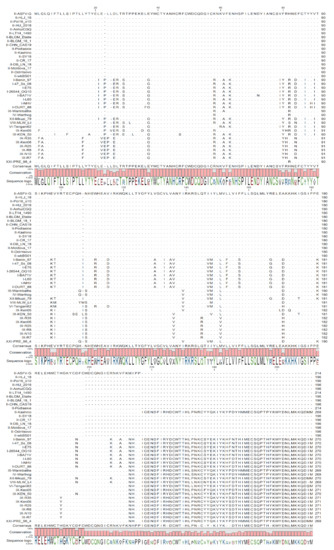
Figure 2.
Multiple sequence alignment of the indicated African swine fever virus (ASFV) isolates of viral protein MGF110-1L. Matching residues are represented as dots. The degree of conservation is below the alignment.
3.3. Development of the ASFV-G-ΔMGF110-1L Deletion Mutant
To study the function of the MGF110-1L gene during ASFV replication in cell cultures and the process of virulence in swine, a MGF110-1L deletion mutant in ASFV-G was developed (ASFV-G-ΔMGF110-1L) (Figure 3). Deletion of MGF110-1L was achieved by substituting the complete ORF of 214 amino acid residues of the MGF110-1L with a p72mCherry cassette following standard methodologies based on homologous recombination [12]. ASFV-G-ΔMGF110-1L was constructed from the highly virulent ASFV Georgia 2007 isolate (ASFV-G). A region spanning 645-bp (between nucleotide positions 7004 and 7648) was deleted from the ASFV-G genome and substituted with a 1226-bp cassette containing the p72mCherry construct (see Material and Methods). ASFV-G-ΔMGF110-1L was obtained after a process of successive limiting dilution purifications in swine macrophage cell cultures. The virus obtained from the last purification round was further amplified in primary swine macrophage cell cultures to obtain a virus stock.
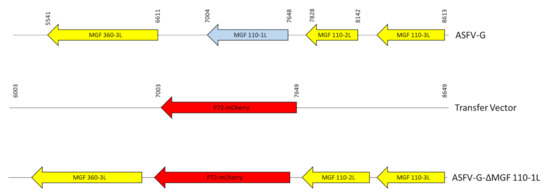
Figure 3.
Schematic for the development of ASFV-G-ΔMGF110-1L. The transfer vector contains the p72 promoter and a mCherry cassette; the flanking left and right arms are indicated, and were designed to have flanking ends to both sides of the deletion/insertion cassette. The resulting ASFV-G-ΔMGF110-1L virus with the cassette inserted is shown on the bottom.
The accuracy of the genetic modifications introduced into ASFV-G-ΔMGF110-1L, as well as the conservation of the integrity of the remaining virus genome was assessed by full genome sequence obtained by NGS on an Illumina NextSeq® 500. The comparison between ASFV-G-ΔMGF110-1L and ASFV-G full-length genomes demonstrated a deletion of 645 nucleotides, which is consistent with the introduced modifications. Furthermore, the ASFV-G-ΔMGF110-1L genome contained a 1226-nucleotide insertion corresponding to the introduction of the p72-mCherry cassette sequence. No additional significant differences were observed between the ASFV-G-ΔMGF110-1L and ASFV-G genomes, confirming that the ASFV-G-ΔMGF110-1L virus did not acquire additional mutations during the process of homologous recombination, or the limiting dilution purification procedure. NGS results also demonstrated the absence of any residual parental ASFV-G genome as a potential contaminant of the ASFV-G-ΔMGF110-1L stock.
3.4. Replication of ASFV-G-ΔC962R in Primary Swine Macrophages
To assess the function of MGF110-1L during virus replication, the in vitro growth kinetics of ASFV-G-ΔMGF110-1L were evaluated in swine macrophage cultures (Figure 4). ASFV-G-ΔMGF110-1L kinetics were compared to that of the parental ASFV-G in a multistep growth curve. Macrophage cultures were infected with either virus at a MOI of 0.01 and samples were collected at 2, 24, 48, 72 and 96 hpi. Results demonstrated that ASFV-G-ΔMGF110-1L displayed a similar growth kinetic when compared to the parental ASFV-G (Figure 5). Thus, deletion of the MGF110-1L gene does not significantly affect the ability of ASFV-G to replicate in swine macrophages. This was surprising, considering that all genomes of ASFV contain MGF110-1L. However, it is possible that the function of MGF110-1L could be duplicated by other MGF110 genes, or another gene in ASFV.

Figure 4.
In vitro growth kinetics in primary swine macrophage cell cultures for ASFV-G-Δ MGF110-1L and parental ASFV-G, infected (MOI = 0.01) with ASFV-G-Δ MGF110-1L or parental ASFV-G viruses. Samples were taken from three independent experiments at the indicated time points and titrated. Data represent means and standard deviations. Sensitivity using this methodology for detecting virus is >log10 1.8 HAD50/mL. No significant differences in viral yields between viruses were observed at any time point tested determined using the Holm-Sidak method (α = 0.05), without assuming a consistent standard deviation. All calculations were conducted using the software Graphpad Prism version 8.
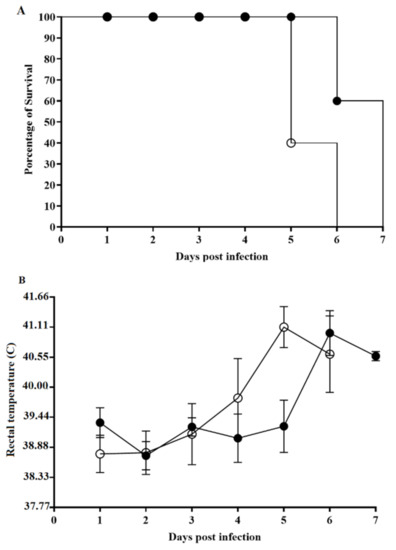
Figure 5.
Evolution of mortality (A) and body temperature (B) in animals (5 animals/group) intramuscularly (IM) infected with 102 HAD50 of either ASFV-G-ΔMGF110-1L (filled symbols) or parental ASFV-G (open symbols). Significant differences (p-value = 0.0201) in the survival course between groups of pigs were found using the test de Long-rank (Mantel-cox test). No statistical differences were found in body temperatures between pigs in both groups, when evaluated by the Holm-Sidak method (α = 0.05). All calculations were conducted using the software Graphpad Prism version 8.
3.5. Assessment of ASFV MGF110-1L Virulence in Swine
To assess the consequences of the deletion of the MGF110-1L gene to ASFV-G virulence, a group (n = 5) of 36–41 kilogram pigs were IM inoculated with 102 HAD50 per animal, while an additional control group was also IM inoculated with 102 HAD50 of the parental ASFV-G. As expected, animals inoculated with virulent ASFV-G had an increase in body temperature (>40 °C) by day 4–5 pi, which was followed by the quick appearance of ASF-associated clinical signs (including anorexia, depression, purple skin discoloration, staggering gai, and diarrhea) (Table 1 and Figure 5).

Table 1.
Swine survival and fever response following infection with ASFV-G-ΔMGF110-1L and parental ASFV-G.
Signs of the disease rapidly aggravated, and animals were euthanized in extremis by day 5–6 pi. Animals receiving ASFV-G-ΔMGF1101L presented with a clinical disease very similar to that described for animals infected with ASFV-G. Both the time of presentation and severity of the clinical signs resembled those present in animals inoculated with the parental virus. Consequently, deletion of the MGF110-1L gene does not alter the virulence phenotype of the highly virulent ASFV-G isolate.
The analysis of viremias in animals IM infected with parental ASFV-G demonstrated expected high titers (106–107.85 HAD50/mL) on day 4 pi, remaining similarly high by day 7 pi, when all animals were euthanized. Animals inoculated with ASFV-G-ΔMGF110-1L presented with viremia values ranging from 106–106.8 HAD50/mL by day 4 pi, reaching similar titers of those animals infected with ASFV-G by day 7 pi, which was also the last sample time taken before animals were humanely euthanized (Figure 6). The presentation of these indistinguishable clinical signs suggests that the MGF110-1L gene is not required for ASFV virulence.
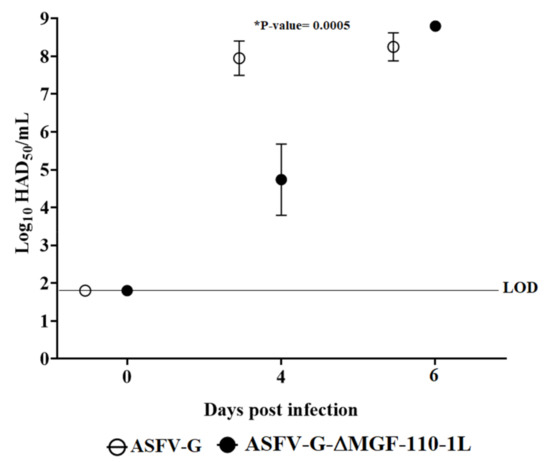
Figure 6.
Viremia titers detected in pigs IM inoculated with 102 HAD50 of either ASFV-G-ΔMGF110-1L (filled symbols) or ASFV-G (empty symbols). Each symbol represents the average of animal titers in each of the groups. Sensitivity of virus detection: >log10 1.8 TCID50/mL. Significant differences in viremia values between both groups of pigs were found at day four post-infection using the Holm-Sidak method (α = 0.05) without assuming a consistent standard deviation. All calculations were conducted on the software Graphpad Prism version 8.
In summary, we determined that MGF110-1L, the only MGF110 family gene, is present in all sequenced isolates, is a highly conserved protein among ASFV isolates [20], is an early protein that is a non-essential gene since its deletion from the ASFV-G genome does not significantly alter virus replication in swine macrophage cultures, and importantly, is not critical for ASFV virulence in swine, as the deletion mutant ASFV-G-ΔMGF110-1L had similar pathogenesis as the parental ASFV-G.
Author Contributions
Data curation, E.R.-M., E.V., N.E., A.R. and S.P.; Formal analysis, E.R.-M., E.V., L.V.-S., E.S., J.Z., M.V.B. and D.P.G.; Funding acquisition, M.V.B. and D.P.G.; Investigation, E.R.-M., E.V., N.E., L.V.-S., A.R., S.P., E.S., J.Z., M.V.B. and D.P.G.; Methodology, E.R.-M. and E.V.; Project administration, M.V.B. and D.P.G.; Supervision, M.V.B. and D.P.G.; Writing—original draft, M.V.B. and D.P.G.; Writing—review & editing, E.R.-M., E.V., M.V.B. and D.P.G. All authors have read and agreed to the published version of the manuscript.
Funding
This project was funded through an interagency agreement with the Science and Technology Directorate of the U.S. Department of Homeland Security under Award Number 70RSAT19KPM000056.
Institutional Review Board Statement
Animal experiments to collect blood for swine macrophages were performed under biosafety level 3AG conditions in the animal facilities at Plum Island Animal Disease Center (PIADC). All experimental procedures were carried out in compliance with the Animal Welfare Act (AWA), the 2011 Guide for Care and Use of Laboratory Animals, the 2002 PHS Policy for the Humane Care and Use of Laboratory Animals, U.S. Government Principles for Utilization and Care of Vertebrate Animals Used in Testing, Research and Training (IRAC 1985), as well as specific animal protocols reviewed and approved by the PIADC Institutional Animal Care and Use Committee of the US Departments of Agriculture and Homeland Security (protocol numbers 205.03-17-R, and 225.02-19-R approved on 09-28-2017 and 09-10-2019, respectively).
Informed Consent Statement
Not Applicable.
Data Availability Statement
Data is contained within the article.
Acknowledgments
We thank the Plum Island Animal Disease Center Animal Care Unit staff for their excellent technical assistance. We wish to particularly thank Melanie V. Prarat for editing the manuscript. This research was supported in part by an appointment to the Plum Island Animal Disease Center (PIADC) Research Participation Program administered by the Oak Ridge Institute for Science and Education (ORISE) through an interagency agreement between the U.S. Department of Energy (DOE) and the U.S. Department of Agriculture (USDA). ORISE is managed by ORAU under DOE contract number DE-SC0014664. All opinions expressed in this paper are the author’s, and do not necessarily reflect the policies and views of USDA, ARS, APHIS, DOE or ORAU/ORISE.
Conflicts of Interest
The authors declare no conflict of interest.
References
- Chapman, D.A.; Darby, A.C.; Da Silva, M.; Upton, C.; Radford, A.D.; Dixon, L.K. Genomic analysis of highly virulent Georgia 2007/1 isolate of African swine fever virus. Emerg. Infect. Dis. 2011, 17, 599–605. [Google Scholar] [CrossRef]
- Costard, S.; Wieland, B.; De Glanville, W.; Jori, F.; Rowlands, R.; Vosloo, W.; Roger, F.; Pfeiffer, D.U.; Dixon, L.K. African swine fever: How can global spread be prevented? Philos. Trans. R. Soc. Lond. Ser. B Biol. Sci. 2009, 364, 2683–2696. [Google Scholar] [CrossRef]
- Tulman, E.R.; Delhon, G.A.; Ku, B.K.; Rock, D.L. African Swine Fever Virus in Lesser Known Large dsDNA Viruses; Springer: Berlin/Heidelberg, Germany, 2009; Volume 328, pp. 43–87. [Google Scholar]
- Borca, M.V.; Ramirez-Medina, E.; Silva, E.; Vuono, E.; Rai, A.; Pruitt, S.; Holinka, L.G.; Velazquez-Salinas, L.; Zhu, J.; Gladue, D.P. Development of a Highly Effective African Swine Fever Virus Vaccine by Deletion of the I177L Gene Results in Sterile Immunity against the Current Epidemic Eurasia Strain. J. Virol. 2020, 94. [Google Scholar] [CrossRef]
- O’Donnell, V.; Holinka, L.G.; Krug, P.W.; Gladue, D.P.; Carlson, J.; Sanford, B.; Alfano, M.; Kramer, E.; Lu, Z.; Arzt, J.; et al. African Swine Fever Virus Georgia 2007 with a Deletion of Virulence-Associated Gene 9GL (B119L), when Administered at Low Doses, Leads to Virus Attenuation in Swine and Induces an Effective Protection against Homologous Challenge. J. Virol. 2015, 89, 8556–8566. [Google Scholar] [CrossRef]
- O’Donnell, V.; Risatti, G.R.; Holinka, L.G.; Krug, P.W.; Carlson, J.; Velazquez-Salinas, L.; Azzinaro, P.A.; Gladue, D.P.; Borca, M.V. Simultaneous Deletion of the 9GL and UK Genes from the African Swine Fever Virus Georgia 2007 Isolate Offers Increased Safety and Protection against Homologous Challenge. J. Virol. 2017, 91. [Google Scholar] [CrossRef]
- Reis, A.L.; Goatley, L.C.; Jabbar, T.; Sanchez-Cordon, P.J.; Netherton, C.L.; Chapman, D.A.G.; Dixon, L.K. Deletion of the African Swine Fever Virus Gene DP148R Does Not Reduce Virus Replication in Culture but Reduces Virus Virulence in Pigs and Induces High Levels of Protection against Challenge. J. Virol. 2017, 91. [Google Scholar] [CrossRef] [PubMed]
- O’Donnell, V.; Holinka, L.G.; Gladue, D.P.; Sanford, B.; Krug, P.W.; Lu, X.; Arzt, J.; Reese, B.; Carrillo, C.; Risatti, G.R.; et al. African Swine Fever Virus Georgia Isolate Harboring Deletions of MGF360 and MGF505 Genes Is Attenuated in Swine and Confers Protection against Challenge with Virulent Parental Virus. J. Virol. 2015, 89, 6048–6056. [Google Scholar] [CrossRef] [PubMed]
- Chen, W.; Zhao, D.; He, X.; Liu, R.; Wang, Z.; Zhang, X.; Li, F.; Shan, D.; Chen, H.; Zhang, J.; et al. A seven-gene-deleted African swine fever virus is safe and effective as a live attenuated vaccine in pigs. Sci. China Life Sci. 2020, 63, 623–634. [Google Scholar] [CrossRef] [PubMed]
- Monteagudo, P.L.; Lacasta, A.; Lopez, E.; Bosch, L.; Collado, J.; Pina-Pedrero, S.; Correa-Fiz, F.; Accensi, F.; Navas, M.J.; Vidal, E.; et al. BA71DeltaCD2: A New Recombinant Live Attenuated African Swine Fever Virus with Cross-Protective Capabilities. J. Virol. 2017, 91. [Google Scholar] [CrossRef] [PubMed]
- O’Donnell, V.; Holinka, L.G.; Sanford, B.; Krug, P.W.; Carlson, J.; Pacheco, J.M.; Reese, B.; Risatti, G.R.; Gladue, D.P.; Borca, M.V. African swine fever virus Georgia isolate harboring deletions of 9GL and MGF360/505 genes is highly attenuated in swine but does not confer protection against parental virus challenge. Virus Res. 2016, 221, 8–14. [Google Scholar] [CrossRef]
- Borca, M.V.; O’Donnell, V.; Holinka, L.G.; Ramírez-Medina, E.; Clark, B.A.; Vuono, E.A.; Berggren, K.; Alfano, M.; Carey, L.B.; Richt, J.A.; et al. The L83L ORF of African swine fever virus strain Georgia encodes for a non-essential gene that interacts with the host protein IL-1β. Virus Res. 2018. [Google Scholar] [CrossRef]
- Ramirez-Medina, E.; Vuono, E.A.; Velazquez-Salinas, L.; Silva, E.; Rai, A.; Pruitt, S.; Berggren, K.A.; Zhu, J.; Borca, M.V.; Gladue, D.P. The MGF360-16R ORF of African Swine Fever Virus Strain Georgia Encodes for a Nonessential Gene That Interacts with Host Proteins SERTAD3 and SDCBP. Viruses 2020, 12, 60. [Google Scholar] [CrossRef]
- Borca, M.V.; O’Donnell, V.; Holinka, L.G.; Risatti, G.R.; Ramirez-Medina, E.; Vuono, E.A.; Shi, J.; Pruitt, S.; Rai, A.; Silva, E.; et al. Deletion of CD2-like gene from the genome of African swine fever virus strain Georgia does not attenuate virulence in swine. Sci. Rep. 2020, 10, 494. [Google Scholar] [CrossRef]
- Afonso, C.L.; Zsak, L.; Carrillo, C.; Borca, M.V.; Rock, D.L. African swine fever virus NL gene is not required for virus virulence. J. Gen. Virol. 1998, 79, 2543–2547. [Google Scholar] [CrossRef] [PubMed]
- Sanford, B.; Holinka, L.G.; O’Donnell, V.; Krug, P.W.; Carlson, J.; Alfano, M.; Carrillo, C.; Wu, P.; Lowe, A.; Risatti, G.R.; et al. Deletion of the thymidine kinase gene induces complete attenuation of the Georgia isolate of African swine fever virus. Virus Res. 2016, 213, 165–171. [Google Scholar] [CrossRef] [PubMed]
- Ramirez-Medina, E.; Vuono, E.A.; Rai, A.; Pruitt, S.; Silva, E.; Velazquez-Salinas, L.; Zhu, J.; Borca, M.V.; Gladue, D.P. The C962R ORF of African Swine Fever Strain Georgia Is Non-Essential and Not Required for Virulence in Swine. Viruses 2020, 12, 676. [Google Scholar] [CrossRef] [PubMed]
- Ramirez-Medina, E.; Vuono, E.; Pruitt, S.; Rai, A.; Silva, E.; Zhu, J.; Velazquez-Salinas, L.; Gladue, D.P.; Borca, M.V. X69R Is a Non-Essential Gene That, When Deleted from African Swine Fever, Does Not Affect Virulence in Swine. Viruses 2020, 12, 918. [Google Scholar] [CrossRef]
- Afonso, C.L.; Alcaraz, C.; Brun, A.; Sussman, M.D.; Onisk, D.V.; Escribano, J.M.; Rock, D.L. Characterization of p30, a highly antigenic membrane and secreted protein of African swine fever virus. Virology 1992, 189, 368–373. [Google Scholar] [CrossRef]
- Borca, M.V.; O’Donnell, V.; Holinka, L.G.; Rai, D.K.; Sanford, B.; Alfano, M.; Carlson, J.; Azzinaro, P.A.; Alonso, C.; Gladue, D.P. The Ep152R ORF of African swine fever virus strain Georgia encodes for an essential gene that interacts with host protein BAG6. Virus Res. 2016, 223, 181–189. [Google Scholar] [CrossRef]
- Rodriguez, J.M.; Garcia-Escudero, R.; Salas, M.L.; Andres, G. African swine fever virus structural protein p54 is essential for the recruitment of envelope precursors to assembly sites. J. Virol. 2004, 78, 4299–4313. [Google Scholar] [CrossRef]
- Garcia-Escudero, R.; Andres, G.; Almazan, F.; Vinuela, E. Inducible gene expression from African swine fever virus recombinants: Analysis of the major capsid protein p72. J. Virol. 1998, 72, 3185–3195. [Google Scholar] [CrossRef]
- Upton, C. Multigene Families in African Swine Fever Virus. Available online: https://4virology.net/organisms/dsdna-viruses/asfarviridae/ (accessed on 20 July 2020).
- Borca, M.V.; Berggren, K.A.; Ramirez-Medina, E.; Vuono, E.A.; Gladue, D.P. CRISPR/Cas Gene Editing of a Large DNA Virus: African Swine Fever Virus. Bio-Protocol 2018, 8. [Google Scholar] [CrossRef]
- Reed, L.J.; Muench, H. A simple method of estimating fifty percent endpoints. Am. J. Hyg. 1938, 27, 493–497. [Google Scholar]
- Borca, M.V.; O’Donnell, V.; Holinka, L.G.; Sanford, B.; Azzinaro, P.A.; Risatti, G.R.; Gladue, D.P. Development of a fluorescent ASFV strain that retains the ability to cause disease in swine. Sci. Rep. 2017, 7, 46747. [Google Scholar] [CrossRef] [PubMed]
- Zhu, J.J.; Ramanathan, P.; Bishop, E.A.; O’Donnell, V.; Gladue, D.P.; Borca, M.V. Mechanisms of African swine fever virus pathogenesis and immune evasion inferred from gene expression changes in infected swine macrophages. PLoS ONE 2019, 14, e0223955. [Google Scholar] [CrossRef] [PubMed]
Publisher’s Note: MDPI stays neutral with regard to jurisdictional claims in published maps and institutional affiliations. |
© 2021 by the authors. Licensee MDPI, Basel, Switzerland. This article is an open access article distributed under the terms and conditions of the Creative Commons Attribution (CC BY) license (http://creativecommons.org/licenses/by/4.0/).